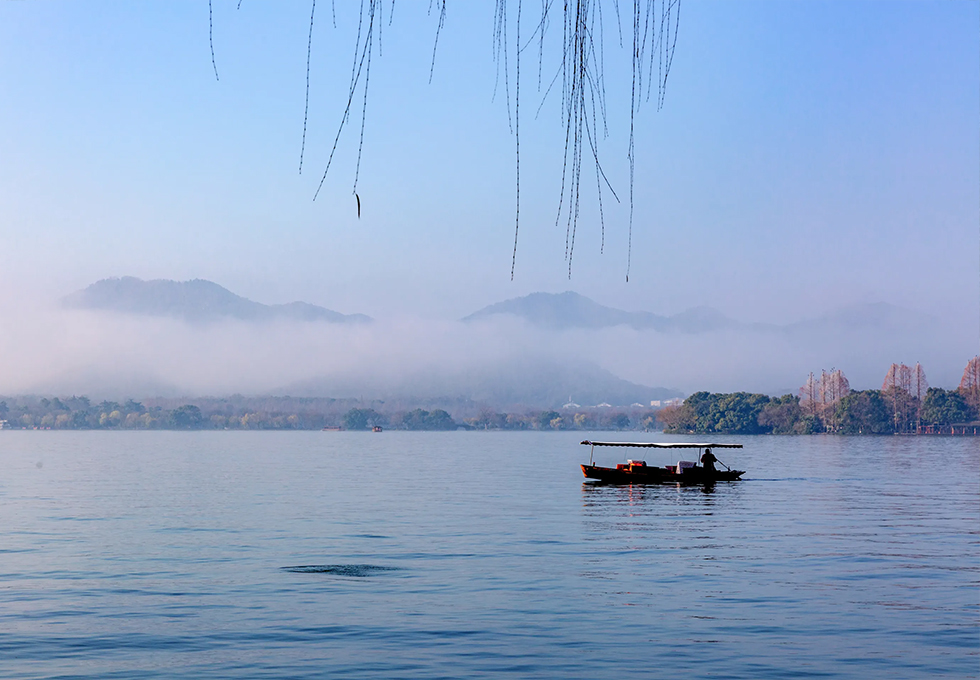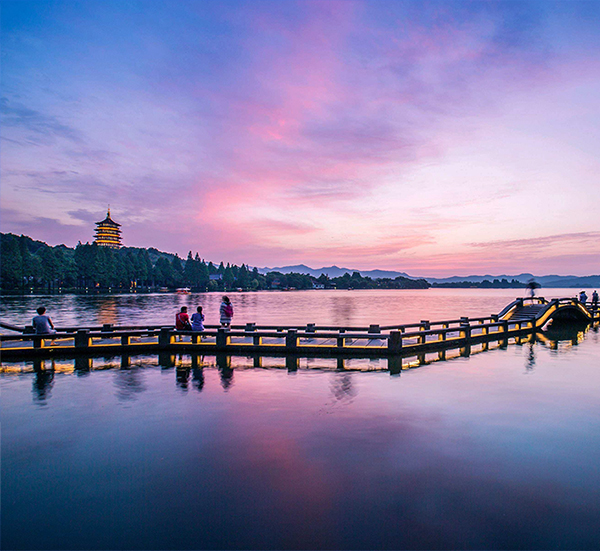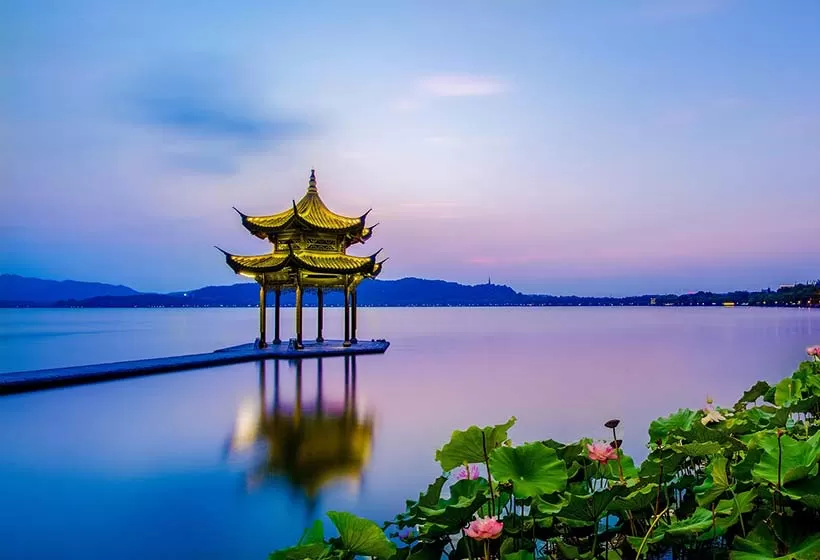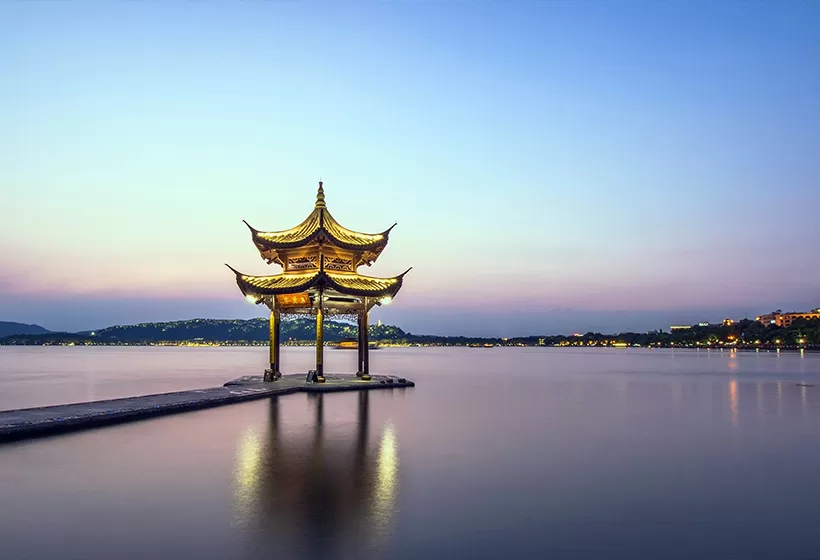Top 10 Famous Tourist Attractions and Sightseeing in Hangzhou
"Above there is heaven, below there are Suzhou and Hangzhou." Hangzhou, a city that has long been praised as a paradise on Earth, holds countless reasons that make it a place people yearn to visit. Most visitors to Hangzhou will not miss West Lake and Xixi Wetlands, with West Lake being the highlight of the trip. In addition, various scenic spots around Hangzhou, like uncut jade, surround the city. Here are the Hangzhou top 10 attractions.
Top 1: West Lake
 The West Lake
The West LakeWest Lake, also known as Qiantang Lake, is located in the western part of Hangzhou city. It covers a catchment area of 21.22 square kilometers, with a lake surface area of 6.38 square kilometers, one of the three famous lakes in Jiangnan.
West Lake is surrounded by mountains on three sides, with the city area to the east. Its shape is roughly elliptical, and the lakebed is relatively flat. The average depth of the lake is 2.27 meters. The lake is divided into five sections—Outer West Lake, West Inner Lake, North Inner Lake, etc.—by Solitary Hill, Bai Causeway, Su Causeway, and Yanggong Causeway. Three small islands, Small Yingzhou, Mid-lake Pavilion, and Ruangong Islet stand in the middle of the Outer West Lake, with Leifeng Pagoda and Baochu Pagoda reflected across the lake from each other, forming a picturesque scene of "One Mountain, Two Towers, Three Islands, Three Causeways, and Five Lakes".
Walking around West Lake, one will notice that the four seasons here flow seamlessly. The summer at West Lake is undoubtedly hot, but the elegance of “Breeze-ruffled Lotus at Quyuan Garden” and the brilliance of “Leifeng Pagoda in Evening Glow” are made all the more striking by this warmth. The winter of West Lake always waits for a snowfall, the snow at Broken Bridge, which has already become a symbolic image in people's minds—whether or not it falls doesn't matter. Even just standing on the bridge and silently reciting "Lingering Snow on Broken Bridge" can evoke a sense of purity and poignant beauty.
The West Lake, with its picturesque scenery and cultural heritage, has also attracted the attention of literati of all ages, and has left a large number of historical sites and stories about the West Lake and ancient Hangzhou in literature.
- Address: No. 1 Longjing Road, Xihu District, Hangzhou
- Open Hours: 00:00 AM – 12:00 PM
- Tour Length: 2-6 hours
Top 2: Leifeng Pagoda
Leifeng Pagoda, originally known as the Princess Pagoda, is situated on Xizhao Mountain on the southern shore of West Lake. The pagoda stands at a height of 71.679 meters and the diameter of the pagoda body is 28 meters. As one of the "Ten Views of West Lake", Leifeng Pagoda is the first colored bronze sculpture pagoda in China.
The pagoda has an octagonal base in the style of Tang and Song dynasty pavilions. Its roof is covered with copper tiles, with copper corbels at the corners and eaves that curve upward. The entire pagoda, both inside and out, is richly decorated with elegance and grandeur, shining brightly with a fresh look and deep cultural significance among the scenic spots of West Lake.
Visitors who ascend the Leifeng Pagoda can enjoy panoramic views of the beautiful West Lake and the bustling city of Hangzhou from the fifth-floor platform. As the highest point on the southern shore of West Lake, it offers a sweeping vista of the lake’s tranquil waters, the charming and graceful Wangzhuang, and the lush, green islands at the center of the lake. From the east shore of West Lake, along Hubin Road, the pagoda appears solid and dignified, while Baochu Pagoda, slender and graceful, stands to the north. The two towers, one to the south and the other to the north, face each other across the lake.
Top 3: Lingyin Temple
Lingyin Temple, an ancient Buddhist temple in China, also known as Yunlin Temple, is nestled at the foot of Beigao Peak, with its front facing Feilai Peak. The two peaks stand side by side, surrounded by towering trees. An ancient temple sets in a deep mountain, where clouds and mist swirl in myriad forms. Originally built in 326 AD during the Eastern Jin Dynasty, it has a history of approximately 1,700 years, making it the oldest temple in Hangzhou.
During the Jiading period of the Song Dynasty, Lingyin Temple was praised as one of the "Five Mountains" of Chan Buddhism in Jiangnan. In the early Qing Dynasty, during the reign of Emperor Shunzhi, the great Zen master Juede managed Lingyin Temple and initiated its reconstruction. The construction of the halls took a staggering eighteen years, during which the grandeur of the temple was revived, making it the "best of the Southeast" in terms of scale. In 1689, during the Kangxi Emperor’s southern tour, the temple was granted the name "Yunlin Chan Temple".
Since its establishment, Lingyin Temple has been a gathering place for eminent monks and scholars, where Confucianism and Buddhism are integrated, while Zen and philosophy are discussed. Additionally, the temple houses a significant collection of historical relics, including Buddha statues, ritual implements, prayer flags, stone steles, royal inscriptions, calligraphy and paintings, which are priceless treasures of Buddhist cultural heritage.
More about the Lingyin Temple »
- Address: No. 1 Fayun Lane, Lingyin Road, Xihu District, Hangzhou
- Open Hours: 07:00 AM – 06:15 PM
- Tour Length: 2-5 hours
Top 4: Feilai Peak
Feilai Peak, located directly south of Lingyin Temple in Hangzhou, is also known as Lingjiu Peak. This mountain, about 800 meters long, 400 meters wide, and 168 meters above sea level, stands out for its unique shape and rock formation, which are distinct from the surrounding peaks. The neighboring mountains, such as Beigao Peak, Meiren Peak, Tianzhu Mountain, and Tianma Mountain, are tall and majestic, made of quartz sandstone. In contrast, Feilai Peak is low and slender, with exposed rocks and striking, bizarre rock formations, that is oval-shaped and made of limestone. Feilai Peak is isolated, surrounded by valleys and ridges. Historical records state that Feilai Peak once had 72 caves, though most have been lost over time. The few that remain are mainly concentrated on the southeastern side of the peak.
Within the caves and on the rock faces, over 380 statues are scattered, making it the largest group of statues in Zhejiang Province. The carvings began in the 951 AD during the Later Zhou of the Five Dynasties, with continued excavation during the Song and Yuan Dynasties, especially in the Song Dynasty. Among these, the most striking is the Maitreya Buddha, smiling broadly with his chest exposed, which is the largest statue at Feilai Peak and a representative example of Song Dynasty sculpture art.- Address: No. 1 Fayun Lane, Lingyin Road, Xihu District, Hangzhou
- Open Hours: 06:30 AM – 05:30 PM
- Tour Length: 2-4 hours
Top 5: Xixi Wetland
Xixi (meaning West Stream) National Wetland Park, located at the junction of Xihu District and Yuhang District, is less than 5 kilometers from West Lake. It is China's first national wetland park and is known as the "Natural Green Lung". Together with West Lake (pronounced as Xihu) and Xiling, it is referred to as the "Three Xis" of Hangzhou.
The charm of Xixi lies in its water. Water is the soul of Xixi, with the wetland's rivers stretching approximately 100 kilometers. About 68% of the area consists of waterways such as rivers, docks, ponds, lakes, and marshes, creating unique wetland scenery of Xixi, making it a true representation of the traditional water towns in Jiangnan.
The beauty of Xixi changes with the seasons, offering different scenes throughout the year. In autumn, you can watch persimmons and listen to the reeds fluttering. In winter, you can walk through the snow and explore the plum blossoms. In early spring, you can take a leisurely stroll through the lush greenery, and in summer, you can pick water chestnuts and admire the lotus flowers. Gently rowing a boat through the waterways, feeling the breeze on your face, and watching birds skim across the water, leaving ripples behind, the scenery in front of you are sure to be intoxicating and mesmerizing.
- Address: No. 518 Tianmushan Road, Xihu District, Hangzhou
- Open Hours: 07:30 AM – 06:30 PM
- Tour Length: 3-8 hours
Top 6: Thousand Islet Lake
Thousand Islet Lake, also known as Xin'anjiang Reservoir, is located in the heart of the Yangtze River Delta, 129 kilometers east of Hangzhou and 140 kilometers west of Mount Huangshan, covering an area of 573 square kilometers. It was created as an artificial lake for the construction of the Xin'anjiang Hydroelectric Power Station, with a dam that intercepts the upstream Xin'an River, forming a vast lake. The surrounding towering mountains are submerged, forming a stunning archipelago of 1,078 islands, thus named "Thousand Islet Lake", one of the "Three Major Thousand-Island Lakes in the World".
The islands in Thousand Islet Lake are scattered across the water, each with its own unique shape and character, and is divided into six scenic zones. Take a boat ride on the lake, enjoying shimmering waters, refreshing breeze, and distant mountains embracing the lake. The islands, dotted across the lake, appear like miniature worlds waiting to be explored.
Meifeng Island as an example, is the iconic island of Thousand Islet Lake. Visitors can take a cable car to the summit, with layers of verdant mountains in the distance, shrouded in mist, where one can enjoy a panoramic view of the entire lake and its islands. Longshan Island, features many ancient buildings along the way. By following the trails, visitors can reach the Ninggu Bell Tower, where they can ring the bell for fun, or enjoy the view of the lake and mountains, gazing across the water toward Qiandao Lake Town in the county.
- Address: Menggu Road, Chun 'an County, Hangzhou
- Open Hours: 09:00 AM – 04:30 PM
- Tour Length: 2-5 hours
Top 7: Song Dynasty Town
Hangzhou Song Dynasty Town, located in the southwest of the West Lake Scenic Area, is bordered by the majestic Wuyun Mountain to the north and the shimmering Qiantang River to the south. Built in the style of the Song Dynasty, Song Dynasty Town’s main structures are modeled after Along the River During the Qingming Festival, recreating the urban landscape of the Song Dynasty. It is Hangzhou’s first large-scale artificial theme park and the country’s earliest theme park dedicated to Song culture. The grand musical The Eternal Love of the Songcheng is the soul of Song Dynasty Town and is considered one of the "Three Great World Shows", alongside Las Vegas's O Show and Paris's Moulin Rouge.
The Song Dynasty Town scenic area is a network of streets and alleys, including East Street, West Street, North Street, Market Street, Rainbow Bridge, and Fenghua Lane, all of which vividly reproduce the prosperous scenes of Bianjing and Lin'an during the Song Dynasty. In the ancient streets and alleys, exciting folk performances, thrilling acrobatics, and stunning musical and dance dramas are continuously staged. The poetic and picturesque natural scenery of the Fairy Mountain and Jade Pavilion Area, along with the exquisite court life and folk customs displayed in the Southern Song Dynasty Imperial Palace Area and the Southern Song Style Park, captivate visitors, transporting them to the distant past.
- Address: No. 148 Zhijiang Road, Xihu District, Hangzhou
- Open Hours: 10:00 AM – 09:00 PM
- Tour Length: 3-5 hours
Top 8: Qiantang River
The Qiantang River, formerly known as "Zhejiang River", is called the "Fuchun River" in the Fuyang section of Zhejiang Province and the "Qiantang River" in the Hangzhou section downstream. The name "Qiantang" first appeared in the Classic of Mountains and Seas, as the river flows through the ancient Qiantang County, one of the main origins of the Wu-Yue culture. The Qiantang River is the largest river in Zhejiang Province and was the source of the province's name when Zhejiang was established in the early Ming Dynasty.
The tidal bore of the Qiantang River is renowned as "the world's number one tide" and is considered one of the greatest natural wonders of the world. It is caused by a combination of gravitational forces and the centrifugal effect of the Earth's rotation, amplified by the unique topography of the Hangzhou Bay's funnel shape, which creates a massive tidal surge. Before the tide arrives, a tiny white dot appears in the distance, which quickly transforms into a thin silver line, accompanied by a thunderous sound similar to distant thunder. The white line rolls toward the shore with great speed. There is barely any time for people to react before the surging tide arrives with a roar. The tidal crest can reach 3 to 5 meters high, with successive waves chasing each other, one layer after another, resembling a long white ribbon with a powerful, overwhelming force akin to the crashing of mountains and seas.
- Open Hours: 00:00 AM – 12:00 PM
- Tour Length: 1-3 hours
Top 9: Qiantang River Bridge
The Qiantang River Bridge is a double-deck truss bridge spanning the Qiantang River in Hangzhou, located to the south of West Lake, near the Liuhe Pagoda. It was designed by the Chinese bridge expert Mao Yisheng and is the first double-deck bridge in China to serve both railway and road traffic. On December 23, 1937, in order to prevent the advancing Japanese army, Mao Yisheng tearfully detonated explosives buried in the bridge piers, watching helplessly as the bridge he had poured his heart and soul into was destroyed. In 1953, after a seven-year restoration, the bridge was successfully rebuilt and reopened, fulfilling Mao Yisheng’s long-held wish to restore it. Walking along the pedestrian walkway of the bridge, one can still feel the weight of its history, with visible bullet marks on the piers and railings that remain as reminders of the past.
- Address: Near Liuhe Pagoda, Xihu District, Hangzhou
- Open Hours: 00:00 AM – 12:00 PM
- Tour Length: 1 hour
Top 10: Hefang Street
Hefang Street is a pedestrian street located in the Shangcheng District of Hangzhou. Its middle section is part of the Qinghefang Historical and Cultural Street area and is the only old street in Hangzhou that has preserved the historical appearance of the ancient city.
The history of Hefang Street dates back to the Southern Song Dynasty. As early as that time, it began to prosper and became a shining pearl beneath the imperial city. Originally named Qinghefang, the street still retains two-story buildings in the Ming and Qing architectural style, serving as living fossils of history. Walking down the street feels like traveling back in time to several centuries ago.
Hefang Street is located very close to the Hangzhou Museum. It is like a long scroll of history, a treasure of Hangzhou's ancient culture, and an integral part of the city's memory. Here, visitors can experience the rich historical and cultural heritage without the need for an admission ticket, immersing themselves in the atmosphere of ancient times.
- Address: No. 180, Hefang Street, Shangcheng District, Hangzhou
- Open Hours: 00:00 AM – 12:00 PM
- Tour Length: 1-4 hours
Customize Your Unique Hangzhou Tour

If you are interested in the Hangzhou itineraries mentioned above, please contact us, and we will be happy to customize it and provide a quote tailored to your preferences.
Alternatively, if you would like to customize your Hangzhou Tour, please visit our Hangzhou Tour Customized Center. We assure you that you will receive a reply within 24 working hours.
Informative Articles for Your Hangzhou Trip
 the West Lake
the West Lake- Travel Guide: attractions, weather, hotels, food, etc.
- Weather: the best time and seasons to visit Hangzhou
- Top attractions: sightseeings to watch in Hangzhou
- Local culture: brief history, folk culture, festivals, etc.
- Top destinations: best places to visit in Hangzhou
- Travel itineraries: itineraries for your reference
- Abundant activities: Hangzhou cultural immersions
- Unique perspective: top interesting things to do
- Local food: what to eat while traveling in Hangzhou
- Luxury hotels: accommodation to stay in Hangzhou
- Hangzhou Tours: customized tours for your reference
GREAT FAMILY CHINA TOUR
JULY 2024 We wanted to thank Grace at China Culture tour for organizing a great tour of China. We enjoyed our Beijing - Xian-Chengdu -Guilin -Yangshuo - Shanghai trip. Our local guides Bruce in Beijing, Susan in Xian, Jane in Chengdu, Mike in Guilin and Mary in Shanghai took care of us…read more details »
Teng Han L from SINGAPORE
Ready to Create a Unique Dream Travel?


